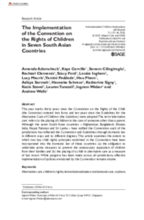Abstract
This year marks thirty years since the Convention on the Rights of the Child (the Convention) entered into force and ten years since the Guidelines for the Alternative Care of Children (the Guidelines) were adopted. The term ‘alternative care’ refers to the placing of children in the care of someone other than a parent. Although the seven South Asian countries – Afghanistan, Bangladesh, Bhutan, India, Nepal, Pakistan and Sri Lanka – have ratified the Convention, each of the jurisdictions has reflected the Convention and Guidelines through domestic law in different ways and to different degrees. This article examines the extent to which two key child rights principles enshrined in the Convention have been incorporated into the domestic law of these countries: (a) the obligation to undertake active measures to prevent the unnecessary separation of children from their families and (b) the placing of a child in alternative care as a measure of last resort. While progress has been made across all jurisdictions, effective implementation of policies envisioned by the Convention remains elusive.
View the article here.
This article is part of the special issue of the Institutionalised Children Explorations and Beyond journal

